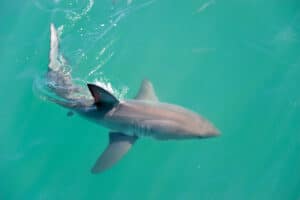Key Points:
- The largest tiger shark caught was 1,785 pounds and 11 ounces, off the coast of Ulladulla, Australia in 2004 by Kevin J. Clapson.
- Due to International Game Fish Association rules, it ties the record set in 1964, when Walter Maxwell caught a 1,780-pound tiger shark measuring 13 feet and 10.5 inches long in North Myrtle Beach, South Carolina.
- Larger tiger sharks have been seen and photographed, such as a female around 16 to 18 feet long in French Polynesia in 2018 that was not able to be properly measured due it it being illegal to capture or tag sharks in sanctuary areas.
The tiger shark, whose dark striped patterns along the sides of its body look very much like its namesake, prowls in search of food throughout the world’s tropical and temperate oceanic ecosystems, from shallow coastal shelves to perilous depths of 1,150 feet. The tiger shark is a member of the requiem shark family, which also includes the blue shark, bull shark, copper shark, and many other species. This family is distinguished by its migratory behavior and ability to bear live young.
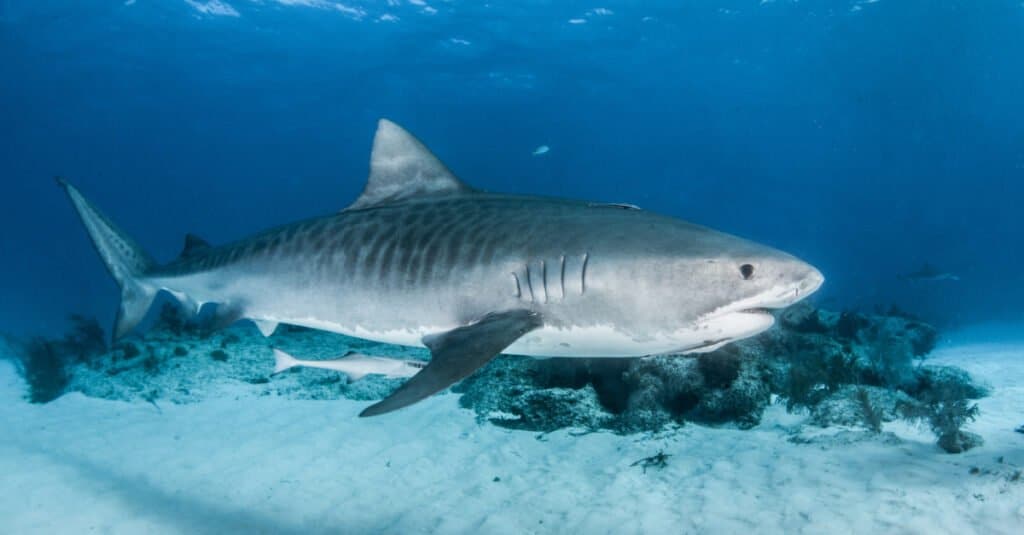
The
tiger
shark gets its name from the vertical lines that run along the side of its body.
©iStock.com/Divepic
More Than Meets the Eye
Tiger sharks normally grow somewhere between 11 and 14 feet in length and between 800 and 1,400 pounds in weight. While male tiger sharks are quite large, the females of this species are even larger, perhaps because the extra weight helps them give birth to so many live young at a time. Litter size can easily range anywhere between 10 and 80 pups, each one measuring between 20 and 30 inches in length at birth.
Because of their size, aggressive behavior, and wide distribution, tiger sharks are considered to be the second deadliest sharks in the world, ranking behind only the great white shark in the number of attacks on humans per year. In terms of sheer size, though, the tiger shark ranks behind several other species, including the whale shark (which stretches up to 48 feet), basking shark (up to 36 feet), great white sharks (up to 22 or 23 feet), Greenland sharks, megamouth sharks, and possibly some hammerhead sharks. It’s also dwarfed by the extinct megalodon, which, at up to 67 feet in length, is the largest shark ever known to exist.
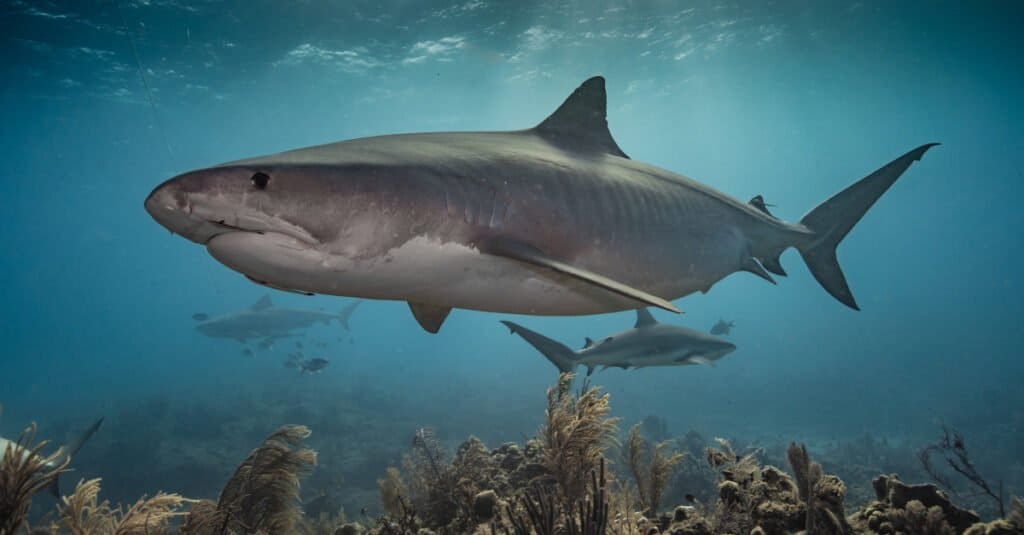
The tiger shark is one of the deadliest sharks in the world.
©iStock.com/Howard Chen
An Apex Predator
The tiger shark is considered to be an apex predator in its natural habitat: it feeds on almost anything it can find, including fish, crustaceans, sea snakes, sea birds, seals, dolphins, and even smaller sharks. But that does not mean they are safe from predation themselves. In 2014, underwater photographers captured footage of several killer whales hunting a tiger shark. After forcing the shark to the surface, the orcas flipped their prey on its back to completely immobilize it. The footage then showed an orca gripping the shark in its mouth and dragging it back underwater to consume it.
So perhaps the tiger shark may not necessarily be the largest predator in the ocean, but there is actually a long and fascinating history of the search for the largest tiger shark ever found. Most world record sharks are only ever documented after they’re already caught and sometimes killed by fishers (though many fishers do release them back into the water after measurement). That’s because it is actually quite difficult to measure a shark directly in the water. Scientists normally have to estimate their size from photographs and video, which is imprecise and difficult.
Setting World Records
One of the most important incidences in the long history of world records took place on June 13, 1964, when a local angler by the name of Walter Maxwell stood on Cherry Grove Pier in North Myrtle Beach, South Carolina, fighting for hours with the largest tiger shark on record for the time. When the shark was almost within reach of the pier, the 130-pound line suddenly snapped, causing him to lose his quarry. Despite the setback, Maxwell went out later that night with his friends in a small boat to search for the enormous fish. Using a live skate as bait, he waited until the next morning before receiving a bite on the line. He reportedly cranked the handle more than 2,000 times while friends poured water on the reel to prevent it from overheating.
After a grueling five-hour fight, he secured the largest tiger shark on record: a 1,780-pound behemoth measuring some 13 feet and 10.5 inches long. It shattered the previous world record by some 300 pounds. Maxwell’s own world record stood for another 40 years by itself.
In 2004, a tiger shark measuring 1,785 pounds and 11 ounces, was caught off the coast of Ulladulla, Australia by Kevin J. Clapson. According to the rules of the International Game Fish Association (IGFA), a new record must be bigger than the previous record by 0.5% — in this case, Clapson’s tiger shark needed to weigh 8 pounds 14 ounces more than than Maxwell’s and it only weighed 5 pounds 11 ounces more, so the IGFA declared the record a tie.
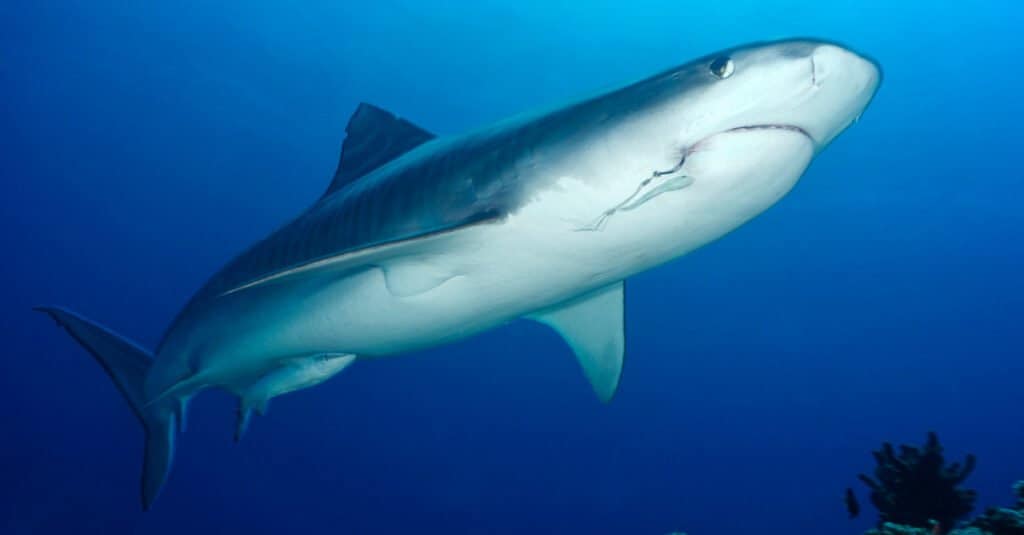
Female tiger sharks are larger than males.
©iStock.com/Yann-HUBERT
This record stands as the largest tiger shark ever caught, but is this the largest tiger shark that has ever been documented? The answer to that question is probably no. Larger sharks have been seen and photographed, though not directly measured. In November 2018, marine biologist Kori Garza was diving into a shark sanctuary near the waters of French Polynesia (situated about halfway between Australia and the Americas), when she encountered a massive female tiger shark, whom she nicknamed Kamakai.
The shark acted calm and non-aggressive around the diver, exhibiting very little territorial behavior. It was estimated to measure somewhere between 16 feet and 18 feet long, smashing the previously known record and probably reaching the upper bounds of what’s possible with this species. The shark was so large that her mouth couldn’t close all the way and she had trouble moving her fins. Since it was illegal to capture or tag any sharks in the sanctuary, the biologists had to let it continue on its way.
Kori Garza later went on a search for the shark with cinematographer Andy Casagrande for the documentary “World’s Biggest Tiger Shark?,” which originally aired on National Geographic’s Sharkfest season. While it was not possible to track the shark directly, marine biologists hoped to identify it again by comparing anatomical evidence. Individual sharks can be distinguished by their appearance, including their stripe patterns, colors, and shape of the dorsal fins (many of the females have unique scarring from the bites of the male as they mate).
While they did not find Kamakai again, Kori Garza claims that the South Pacific area near Tahiti and French Polynesia is an underrated hotspot for tiger shark activity; it’s perhaps every bit as interesting as Tiger Beach and the rest of the Bahamas, where most of the tiger shark footage is usually taken.
She also claims that tiger sharks in the South Pacific appear to be growing larger than normal, perhaps as a result of a healthier overall marine ecosystem. This may suggest that a larger shark than Kamakai may exist somewhere out in the depths of the ocean, awaiting discovery.
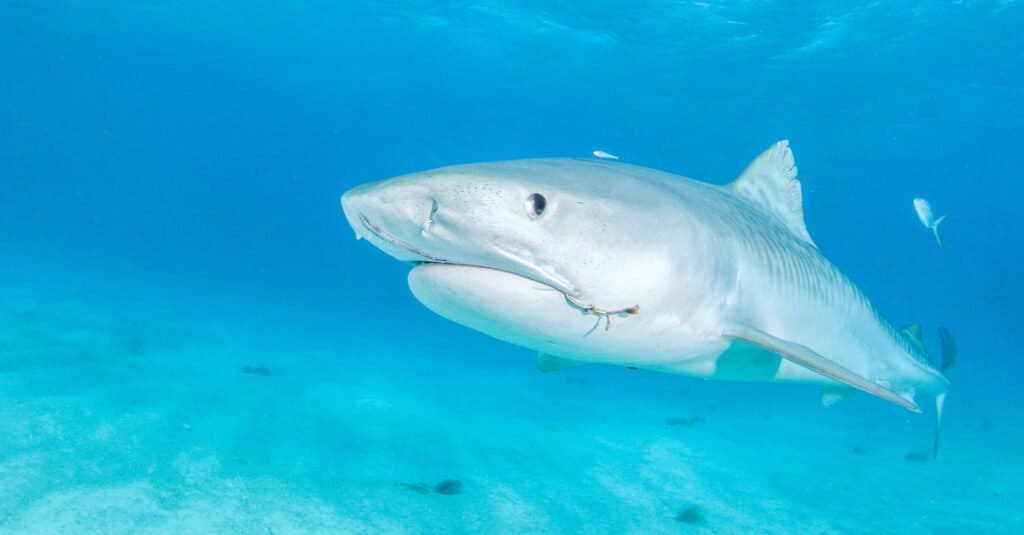
Tiger sharks eat almost anything, including other sharks.
©Michael Bogner/Shutterstock.com
The photo featured at the top of this post is © Yoshinori/Shutterstock.com
Thank you for reading! Have some feedback for us? Contact the AZ Animals editorial team.





